
Types of Adjectives
There are several different types of adjectives that serve different functions in English grammar.
Here are some common types of adjectives:
Descriptive Adjectives: These adjectives describe or provide more information about a noun, giving details about its appearance, quality, or characteristics.
Example: beautiful, tall, blue, delicious.
Demonstrative Adjectives: These adjectives indicate or point out specific nouns by demonstrating their proximity or distance in relation to the speaker.
Example: this, that, these, those.
Possessive Adjectives: These adjectives show ownership or possession, indicating that something belongs to someone or something else.
Example: my, your, his, her, their.
Quantitative Adjectives: These adjectives indicate the quantity or amount of a noun, providing numerical or specific information.
Example: many, few, several, all, some.
Interrogative Adjectives: These adjectives are used to ask questions about a noun, seeking specific information.
Example: which, what, whose.
Indefinite Adjectives: These adjectives refer to nonspecific or unidentified nouns, indicating an unspecified quantity or quality.
Example: some, any, several, few.
Comparative and Superlative Adjectives: These adjectives are used to compare the degree or intensity of a quality between two or more nouns. The comparative form compares two nouns, while the superlative form compares three or more nouns.
Example: tall, taller, tallest.
Proper Adjectives: These adjectives are derived from proper nouns, such as countries, regions, or specific names, and are used to describe nouns related to those entities.
Example: American, French, Shakespearean.
Compound Adjectives: These adjectives are formed by combining two or more words to describe a noun. They are often hyphenated.
Example: well-known, blue-eyed, high-pitched.
Emphasizing Adjectives: These adjectives are used to add emphasis or intensify a quality or characteristic of a noun.
Example: absolute, complete, sheer.
These different types of adjectives serve various purposes in modifying nouns and providing additional information. Understanding their functions can help you use them effectively in your writing or speech to create more precise and engaging descriptions.




